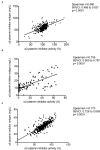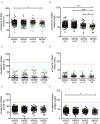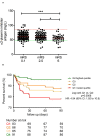Low α2-Plasmin Inhibitor Antigen Levels on Admission Are Associated With More Severe Stroke and Unfavorable Outcomes in Acute Ischemic Stroke Patients Treated With Intravenous Thrombolysis
- PMID: 35911531
- PMCID: PMC9334909
- DOI: 10.3389/fcvm.2022.901286
Low α2-Plasmin Inhibitor Antigen Levels on Admission Are Associated With More Severe Stroke and Unfavorable Outcomes in Acute Ischemic Stroke Patients Treated With Intravenous Thrombolysis
Abstract
Background: Intravenous administration of recombinant tissue plasminogen activator (rt-PA) fails to succeed in a subset of acute ischemic stroke (AIS) patients, while in approximately 6-8% of cases intracerebral hemorrhage (ICH) occurs as side effect.
Objective: Here, we aimed to investigate α2-plasmin inhibitor (α2-PI) levels during thrombolysis and to find out whether they predict therapy outcomes in AIS patients.
Patients/methods: In this prospective, observational study, blood samples of 421 AIS patients, all undergoing i.v. thrombolysis by rt-PA within 4.5 h of their symptom onset, were taken before and 24 h after thrombolysis. In a subset of patients (n = 131), blood was also obtained immediately post-lysis. α2-PI activity and antigen levels were measured by chromogenic assay and an in-house ELISA detecting all forms of α2-PI. α2-PI Arg6Trp polymorphism was identified in all patients. Stroke severity was determined by NIHSS on admission and day 7. Therapy-associated ICH was classified according to ECASSII. Long-term outcomes were defined at 3 months post-event by the modified Rankin Scale (mRS).
Results: Median α2-PI activity and antigen levels showed a significant drop immediately post-lysis and increased to subnormal levels at 24 h post-event. Admission α2-PI levels showed a significant negative stepwise association with stroke severity. Patients with favorable long-term outcomes (mRS 0-1) had significantly higher admission α2-PI antigen levels (median:61.6 [IQR:55.9-70.5] mg/L) as compared to patients with poor outcomes (mRS 2-5: median:59.7 [IQR:54.5-69.1] and mRS 6: median:56.0 [IQR:48.5-61.0] mg/L, p < 0.001). In a Kaplan-Meier survival analysis, patients with an α2-PI antigen in the highest quartile on admission showed significantly better long-term survival as compared to those with α2-PI antigen in the lowest quartile (HR: 4.54; 95%CI:1.92-10.8, p < 0.001); however, in a multivariate analysis, a low admission α2-PI antigen did not prove to be an independent risk factor of poor long-term outcomes. In patients with therapy-related ICH (n = 34), admission α2-PI antigen levels were significantly, but only marginally, lower as compared to those without hemorrhage.
Conclusions: Low α2-PI antigen levels on admission were associated with more severe strokes and poor long-term outcomes in this cohort. Our results suggest that in case of more severe strokes, α2-PI may be involved in the limited efficacy of rt-PA thrombolysis.
Keywords: acute ischemic stroke; fibrinolysis; intracerebral hemorrhage (ICH); outcome; recombinant tissue plasminogen activator (rt-PA); thrombolysis; α2-plasmin inhibitor.
Copyright © 2022 Székely, Orbán-Kálmándi, Szegedi, Katona, Baráth, Czuriga-Kovács, Lóczi, Vasas, Fekete, Fekete, Berényi, Oláh, Csiba and Bagoly.
Conflict of interest statement
The authors declare that the research was conducted in the absence of any commercial or financial relationships that could be construed as a potential conflict of interest.
Figures






Similar articles
-
Elevated Factor VIII and von Willebrand Factor Levels Predict Unfavorable Outcome in Stroke Patients Treated with Intravenous Thrombolysis.Front Neurol. 2018 Jan 23;8:721. doi: 10.3389/fneur.2017.00721. eCollection 2017. Front Neurol. 2018. PMID: 29410644 Free PMC article.
-
A modified in vitro clot lysis assay predicts outcomes and safety in acute ischemic stroke patients undergoing intravenous thrombolysis.Sci Rep. 2021 Jun 16;11(1):12713. doi: 10.1038/s41598-021-92041-1. Sci Rep. 2021. PMID: 34135389 Free PMC article.
-
PAI-1 5G/5G genotype is an independent risk of intracranial hemorrhage in post-lysis stroke patients.Ann Clin Transl Neurol. 2019 Nov;6(11):2240-2250. doi: 10.1002/acn3.50923. Epub 2019 Oct 21. Ann Clin Transl Neurol. 2019. PMID: 31637872 Free PMC article.
-
Evaluating the safety and efficacy of intravenous thrombolysis for acute ischemic stroke patients with a history of intracerebral hemorrhage: a systematic review and meta-analysis.J Thromb Thrombolysis. 2022 Feb;53(2):485-494. doi: 10.1007/s11239-021-02531-2. Epub 2021 Jul 24. J Thromb Thrombolysis. 2022. PMID: 34302590
-
Thrombolysis in acute stroke patients with cerebral small vessel disease.Cerebrovasc Dis. 2014;37(1):5-13. doi: 10.1159/000356796. Epub 2013 Dec 17. Cerebrovasc Dis. 2014. PMID: 24355873 Review.
Cited by
-
Coagulation biomarkers for ischemic stroke.Res Pract Thromb Haemost. 2023 Apr 23;7(4):100160. doi: 10.1016/j.rpth.2023.100160. eCollection 2023 May. Res Pract Thromb Haemost. 2023. PMID: 37274178 Free PMC article.
References
-
- Powers WJ, Rabinstein AA, Ackerson T, Adeoye OM, Bambakidis NC, Becker K, et al. . 2018 guidelines for the early management of patients with acute ischemic stroke: a guideline for healthcare professionals from the American Heart Association/American Stroke Association. Stroke. (2018) 49:e46–e110. 10.1161/STR.0000000000000158 - DOI - PubMed
LinkOut - more resources
Full Text Sources
Research Materials
Miscellaneous

